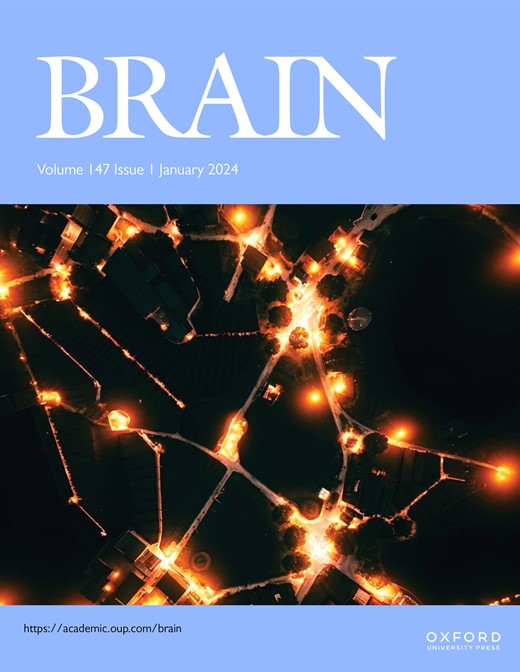Cell-specific Eif2b5 mutant mice: novel insights into roles of macroglia in vanishing white matter
IF 10.6
1区 医学
Q1 CLINICAL NEUROLOGY
引用次数: 0
Abstract
Vanishing white matter (VWM) is a leukodystrophy caused by mutations in any of the genes encoding the subunits of the eukaryotic translation initiation factor 2B (eIF2B), a central factor in mRNA translation initiation and regulator of the translation rate during the integrated stress response (ISR). Clinically, VWM is characterized by chronic motor and cognitive decline and premature death. Neuropathology shows selective white matter involvement with dysmorphic, immature astrocytes and defective reactive astrogliosis, while oligodendrocytes show increased expression of immaturity and proliferation markers and neurons look normal. The expression of the ATF4-transcriptome is increased in the white matter. These characteristics have been successfully replicated in eIF2B mutant mouse models. Until now, the relative contribution of each cell type to the development of VWM has remained unclear. Understanding the vulnerability of specific cell types for VWM is critical for understanding disease mechanisms and developing effective therapies. We generated astrocyte-, oligodendrocyte-, and neuron-specific Eif2b5 conditional mouse lines to determine the role of each mutant cell type in the onset and development of the disease. We evaluated motor performance, white matter pathology and the expression of myelin-related proteins. We analyzed astrocytes and oligodendrocytes density, maturity, morphology, proliferation, and apoptosis. We investigated the expression of the ISR-/ATF4-related genes and proteins, as well as their localization within the glial cells. At age 9 months, we found that astrocyte-specific Eif2b5 conditional mice showed very mild ataxia, extensive intramyelinic vacuolization, normal density and maturity of oligodendrocytes, and high expression of ATF4-related genes. Oligodendrocyte-specific Eif2b5 conditional mice developed gait ataxia that matched the phenotype of the whole-body Eif2b5 mutant line. Myelin looked normal, but numerous axons were unmyelinated; astrocytes were reactive, and oligodendrocytes were immature and in cell cycle. The enhanced ATF4-transcriptome was minor compared to the astrocyte-specific lines. The neuron-specific Eif2b5 conditional line exhibited a very mild phenotype and none of the major characteristic of VWM. Our findings highlight a complex effect of Eif2b5 mutations in different brain cell types leading to the clinical and neuropathological characteristics of VWM. Oligodendrocytes are the major contributors to the development of ataxia, but astrocyte-specific Eif2b5 conditional mice display several histological and molecular key features of VWM. In conclusion, the view of a single cell population being responsible for the onset and development of VWM needs to be replaced by the concept of VWM as a disease involving diverse cell types.细胞特异性Eif2b5突变小鼠:大胶质细胞在白质消失中的作用的新见解
消失白质(VWM)是一种由真核翻译起始因子2B (eIF2B)亚基编码基因突变引起的白质营养不良,eIF2B是mRNA翻译起始的核心因子,是综合应激反应(ISR)中翻译速率的调节因子。临床上,VWM的特点是慢性运动和认知能力下降和过早死亡。神经病理学显示选择性白质累及畸形、未成熟的星形胶质细胞和有缺陷的反应性星形胶质细胞,而少突胶质细胞显示不成熟和增殖标志物的表达增加,神经元看起来正常。atf4转录组在白质中表达增加。这些特征已在eIF2B突变小鼠模型中成功复制。到目前为止,每种细胞类型对VWM发展的相对贡献仍不清楚。了解特定细胞类型对VWM的脆弱性对于理解疾病机制和开发有效的治疗方法至关重要。我们生成星形胶质细胞、少突胶质细胞和神经元特异性Eif2b5条件小鼠系,以确定每种突变细胞类型在疾病发生和发展中的作用。我们评估了运动表现、白质病理和髓磷脂相关蛋白的表达。我们分析了星形胶质细胞和少突胶质细胞的密度、成熟度、形态、增殖和凋亡。我们研究了ISR-/ atf4相关基因和蛋白的表达,以及它们在胶质细胞中的定位。在9月龄时,我们发现星形胶质细胞特异性Eif2b5条件小鼠表现出非常轻微的共济失调,广泛的髓内空泡化,少突胶质细胞密度和成熟度正常,atf4相关基因高表达。少突胶质细胞特异性Eif2b5条件小鼠出现步态共济失调,与全身Eif2b5突变系的表型相匹配。髓鞘正常,但大量轴突无髓鞘;星形胶质细胞反应性强,少突胶质细胞未成熟,处于细胞周期。与星形胶质细胞特异性细胞系相比,增强的atf4转录组较少。神经元特异性Eif2b5条件系表现出非常温和的表型,没有VWM的主要特征。我们的研究结果强调了Eif2b5突变在不同脑细胞类型中导致VWM临床和神经病理特征的复杂作用。少突胶质细胞是共济失调发展的主要贡献者,但星形胶质细胞特异性Eif2b5条件小鼠表现出VWM的几个组织学和分子关键特征。综上所述,单一细胞群负责VWM的发生和发展的观点需要被VWM作为一种涉及多种细胞类型的疾病的概念所取代。
本文章由计算机程序翻译,如有差异,请以英文原文为准。
求助全文
约1分钟内获得全文
求助全文
来源期刊

Brain
医学-临床神经学
CiteScore
20.30
自引率
4.10%
发文量
458
审稿时长
3-6 weeks
期刊介绍:
Brain, a journal focused on clinical neurology and translational neuroscience, has been publishing landmark papers since 1878. The journal aims to expand its scope by including studies that shed light on disease mechanisms and conducting innovative clinical trials for brain disorders. With a wide range of topics covered, the Editorial Board represents the international readership and diverse coverage of the journal. Accepted articles are promptly posted online, typically within a few weeks of acceptance. As of 2022, Brain holds an impressive impact factor of 14.5, according to the Journal Citation Reports.
 求助内容:
求助内容: 应助结果提醒方式:
应助结果提醒方式:


